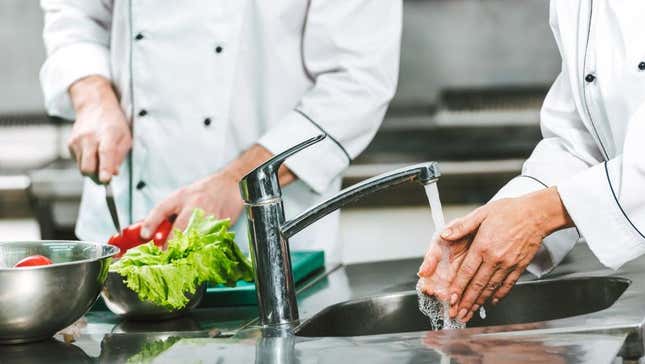
Professional kitchens present plenty of hazards. You’ll find sharp tools everywhere, and risks increase as people rush past each other in an enclosed space. But surprisingly, the placement of knives and scalding hot frying oil aren’t the safety issues restaurants are failing on. A new report shows that at America’s restaurants, the top violation of the Food and Drug Administration’s food code was, surprisingly, related to handwashing.
The report, compiled by Hazel Analytics, examined data from two million restaurant health inspections from September 2022 to September 2023, and its findings were shared at the 2023 Nation’s Restaurant News Food Safety Symposium. It states that almost 6% of restaurants inspected received violations for “inadequate handwashing stations.” Although that percentage may seem low, it’s the highest percentage for any single violation, and it shakes out to about 120,000 restaurants.
Food service and hygiene should go hand in hand
The pandemic impacted restaurants heavily and on many fronts. While in-person dining took a hit and restaurants had to pivot to better meet customers’ needs at home, hygiene was also on everyone’s mind when considering whether to purchase non-homemade meals. Handwashing, disinfecting surfaces, and keeping things sparkling clean became even more important than ever before.
“Inadequate handwashing stations” is a specific violation that is not necessarily related to the frequency with which employees are washing their hands. The FDA has clear guidelines on what restaurants must supply to employees so the latter can wash their hands as well and frequently as possible. Here’s a partial list of requirements:
- “Adequate, readily accessible hand-washing facilities”
- Soap
- Running water that’s treated in accordance with FDA guidelines
- “Adequate drying devices,” which include “single service towels, sanitary towel service, or electric hand dryers” (note that this doesn’t include using food prep side towels!)
- “Appropriate disposal of waste,” like a kitchen sink far from exposed fresh produce and a covered garbage can for used paper towels
- Hand sanitizer is not an acceptable swap for soap and water
Behind handwashing, other common violations noted in the report include sanitizing food contact surfaces (5.6%), having a certified food protection manager present (4.4%), proper cold holding temperatures (3.7%), and food obtained from an approved source (3.5%).
Of course, as is often the case, this data doesn’t tell the whole story. Though restaurants may be losing steam when it comes to the rigor with which they stay on top of health and safety measures, the FDA is also becoming more strict in its calling out those violations, perhaps leading to some portion of this uptick.
“Health department inspection focus has shifted significantly,” said Loveleen Lohia, customer success manager at Hazel Analytics, to NRN. “We analyze 255 health departments… and we’ve noticed that […] there has been an increase on the regulatory side on citing those violations much more than before COVID.”
We are entering a season notorious for the spread of illness, so it’s a good time to remember the importance of handwashing (and, wherever applicable, glove changing), and restaurants should be making it a seamless part of the employee experience. If there’s one thing those early days of COVID taught us, it’s that proper sanitizing can be as simple as humming along to Kelly Clarkson’s “Since U Been Gone.”
